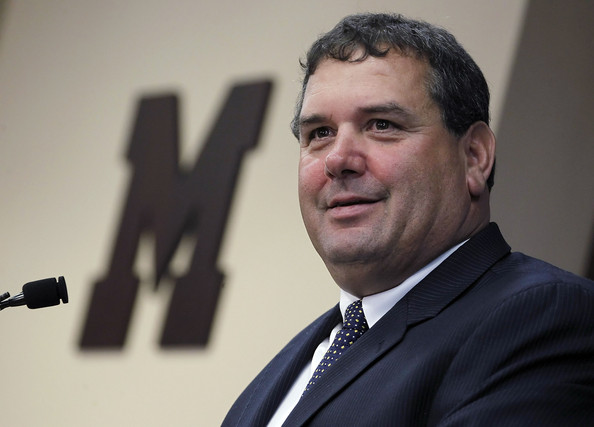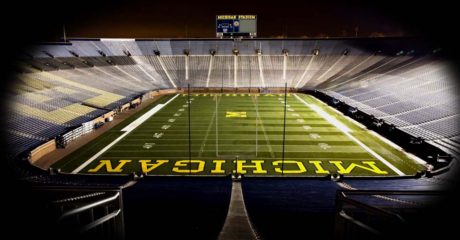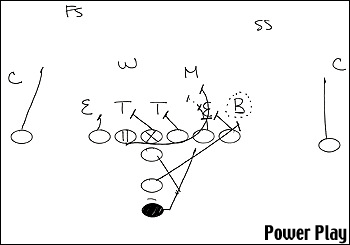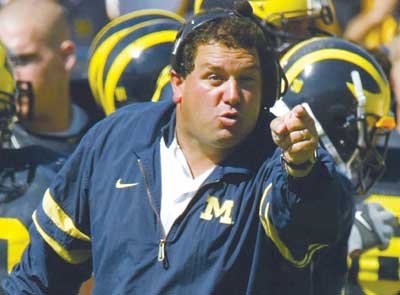Who cares what you call it?
 |
| Brady Hoke says “tough” too much. Whatever that means. |
I try not to turn my blog into one of those that calls out competing* blogs in order to establish some sort of superiority. Because, after all, the blogosphere has been kind to me. The guys at Maize ‘n’ Brew asked me to join them, MGoBlog and The Wolverine Blog link to my site on occasion, etc. My blog is mostly for my pleasure, not because I want to get rich or win any awards.
But Brian over at MGoBlog wrote a post today that bugged me a bit, so I’m responding at length. He takes issue with Brady Hoke’s comments about running the “power play” and makes tongue-in-cheek comments about “manball” and “toughness.” I just don’t see the point.
Brian says:
There are consistent reports that Hoke makes condescending comments about the spread at alumni events. Manball? Manball.
He then goes on to suggest that all people who agree with Hoke’s offensive and verbal philosophies are old, mustachioed, and averse to change.
Well . . . okay. So what? Football’s rules have largely been the same since the forward pass was legalized. Eleven guys on the field, four downs to get ten yards, etc. The emergence of the single wing offense in recent years blew people’s minds. How can you have a running back taking snaps and gaining yards?!?!?! Well, it’s because football is football. Blockers need to block, runners need to run, receivers need to catch, tacklers need to tackle. People didn’t figure out how to stop the single wing before it disappeared around the time of Al Capone. It just got boring. So teams started running the wishbone triple option. Then they started running I-formation plays. Then they took out the fullback and created the run-n-shoot. Then they put the quarterback in the shotgun formation and gave him five wide receivers.
What’s the common theme? All of them work. You know, if they’re run well. Paul Johnson is making the triple option work at Georgia Tech, Chip Kelly runs the spread-n-shred at Oregon, and Bret Bielema scored 83 points in one game using good ol’ fashioned power running at Wisconsin.
It seems Brian is infuriated that Hoke would be audacious enough to speak condescendingly about the spread (and zone blocking in particular), but this is what coaches do. Bo Schembechler liked to run the ball and never shied away from his disdain for throwing the ball. But his teams ran the ball well, so it was okay. Mike Leach threw the ball all over the place at Oklahoma and Texas Tech and thinks throwing the ball gives him an advantage over teams that run the ball more. It works. Why does it matter? If Brian were asked, I bet he could completely eviscerate other successful blogs. He could find fault with their advertising, their commenting formats, their content, etc. In fact, he does this type of thing quite often, at least as far as content goes. He thinks his blog is superior to others. If he didn’t, he would change. And that’s fine. But if those blogs are gaining readership and making money, then it’s all just useless babble.
Of course, much of his stance is based on the fact that Denard Robinson, a Dodge Viper in a Jeep Wrangler world, is Michigan’s quarterback. Robinson possesses the talent to be perhaps the most electrifying spread option quarterback in the history of the game (however short the history of the spread option is), but now he’ll be playing under a coach who eschews zone blocking and likes fullbacks. And it’s true that Robinson was a Heisman frontunner at one point in 2010, a record-breaking signal caller who took the country by storm with his speed, elusiveness, smile, dreadlocks, and failure to tie his shoes. That’s not something that should be completely dismissed.
But when it comes down to it, a coach has to meld a player and a system together. He shouldn’t change the system to fit a player, and he shouldn’t abandon a talented player just because the player isn’t an ideal fit.
Hoke said . . .
Once we get the power play down, then we’ll go to the next phase. You know, because we’re gonna run the power play.
. . .which makes Brian unhappy. He talks about how Michigan has athletic linemen and a tiny starting running back (Vincent Smith), which doesn’t exactly make you think “power run.” Power plays are usually left to mammoth offensive linemen, battering-ram fullbacks, and tailbacks with thighs like tree trunks.
Except Michigan’s offensive line was already inching its way toward 300 pounds across the board, Hoke ran plenty of split back sets in 2010 at San Diego State, and running backs coach Fred Jackson has essentially said, “Vincent Smith will probably not be our starter in 2011.”
The power is the base play of Brady Hoke’s philosophy. Just like any intelligent person wouldn’t have expected Rich Rodriguez to run many powers and whams from the I-formation in 2008, Brian shouldn’t expect Hoke to run loads of quarterback iso’s and and zone stretches in 2011. That’s not Hoke’s game, or Borges’s. Rodriguez ran the zone read option with two stiffs at quarterback, Nick Sheridan and Steve Threet. They were game stiffs, but they shouldn’t have been in an offense that required them to run so much. Michigan won three games. Put those guys in a pro-style offense, and I bet they would have won . . . four (the same three plus Toledo). The difference is minuscule. Meanwhile, those running backs, linemen, and receivers gained experience that allowed them to improve in 2009 and then 2010. The growth of David Molk and Martavious Odoms, for example, would have been stunted if they had to play in a pro-style offense that first year. Molk wouldn’t have had practice with the timing and accuracy of those shotgun snaps, and Odoms might have spent the year sitting on the bench. After all, who needs a 5’9″ freshman receiver when you’ve got a two-back, I-formation base set?
And why wouldn’t the power play be the first thing for Michigan’s players to learn? You don’t hire Rich Rodriguez to run the counter trey, you don’t hire Mark McGwire to teach your hitters how to bunt for a single, and you don’t hire Christina Aguilera to teach you the National Anthem.
10. I-formation, three-wide – Power run
11. I-formation – Play action pass
12. Shotgun, three-wide – Pass
13. Split backs – Power run
14. Shotgun, split backs – Screen pass
15. Shotgun, three-wide – Pass
16. Shotgun, three-wide – Zone read option
17. I-formation – Power run
18. Shotgun, three-wide – Pass
19. I-formation – Play action pass
20. Single back, three-wide – Pass
21. Shotgun, three-wide – Pass
22. I-formation – Play action pass
23. I-formation – Power run
24. Shotgun, three-wide – Pass
25. Split backs – Pass
26. I-formation – Naked bootleg pass
27. I-formation – Draw
28. Shotgun, three-wide – Draw
29. Shotgun, four-wide – Pass
30. I-formation – Play action pass
31. I-formation – Iso run
32. Shotgun, split backs – Pass
33. Single back, three-wide – Pass
34. I-formation (on the goal line) – Power run
35. Single back – Dive
36. I-formation – Play action pass
37. I-formation – Zone run
38. I-formation – Play action pass
39. Shotgun, three-wide – Screen pass
40. Split backs – Power run
41. I-formation – Play action pass
42. Split backs – Screen pass
43. I-formation – Pass
44. Split backs – Dive
45. Shotgun, four-wide – Rollout pass
46. Shotgun, four-wide – Pass
I’m using “power run” a little loosely because I don’t want to break down every play – this isn’t a UFR – but the strategy of using a fullback and a pulling lineman is there. Fifteen of those plays (or about 33%) are either based on power running or, in the case of play action, the threat of the power run. These numbers are only based on one game against a very good team, which SDSU trailed for most of the time. But when roughly one-third of a coach’s offense is rooted in a single series of plays, you can’t just scrap the whole thing.
I think the mindset regarding Denard has morphed into “Give him the ball every play and don’t let anyone else mess it up.” Which is fine until your quarterback carries the ball almost 300 times in one season and misses time in ten out of twelve games due to injury. As we saw this past season, the threat of Denard Robinson running the ball was practically just as dangerous as him actually running it. There were all kinds of examples of wide open receivers running free because Denard took a single step toward the line of scrimmage.
There are multiple ways to use his speed, not just as a 300-carry feature back. He can run the naked bootleg (seen in the above playlist), he can sprint out from the shotgun (seen in the above playlist), he can run a quarterback draw (not seen above, but SDSU’s quarterback was s….l….o….w), etc. Run a play action bootleg and see what defensive end or outside linebacker can handle him out on the edge. It won’t look the same as last year, but it can be effective.
Brian also complains about Hoke’s frequent use of some form of the word “toughness.” I agree that it’s a platitude, but welcome to coachspeak. Find me a coach who doesn’t use the word “tough” more often than a Ford commercial, I dare you.
Furthermore, watch Michigan’s team in 2010. Third-and-short on offense? Michigan can’t line up and run the ball. Third-and-short (or third-and-medium, or third-and-long, third-and-a-parsec)? Michigan can’t get a stop. Need a broken tackle? You won’t get it from Shaw or Smith. Need a tackler to stop someone in his tracks? If it’s not Jordan Kovacs, it’s probably not happening. I won’t question any individual player’s toughness, but the team as a whole could use an injection of it. All coaches preach toughness, but if it takes Brady Hoke repeating the word “tough” until his face turns blue to get his team to actually play like it, then I’m fine with it.
Conclusions and predictions:
- Rich Rodriguez’s 2010 offense was good. So was Brady Hoke’s. Brady Hoke is not Rich Rodriguez. And despite both being somewhere between chunky and fat, Al Borges is not Calvin Magee.
- If Brady Hoke can teach his players how to run the system, it will be successful. If he can’t, it won’t.
- The zone read option won’t disappear completely from Michigan’s offense, but it doesn’t really matter. Denard Robinson rarely ran it for Rodriguez, and it wasn’t very effective when he did.
- If Ronnie Hillman can run the power frequently and gain 1,500 yards on the ground, then Michigan can find a running back on its roster to run the ball with some consistency. That player will not be Vincent Smith.
- Coaches will continue to say “tough,” coaches will continue to say “execute,” but the next time a platitude in March decides the outcome of a game in November will be the first.
- My advice to impatient and angry Michigan fans is to wait and see what happens. I wasn’t a huge fan of the Brady Hoke hire when it happened, either, but I am very confident that Michigan will improve defensively. This offense probably won’t be quite as explosive as the 2010 version, but an above average offense combined with an improved defense should improve upon the win total from last season.
*I don’t know what else to call them, but we all know they’re more popular blogs than mine.






